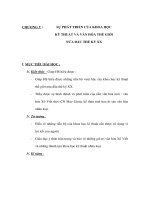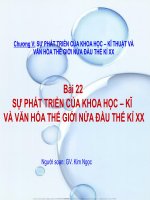dịch thuật và văn hóa docx
Bạn đang xem bản rút gọn của tài liệu. Xem và tải ngay bản đầy đủ của tài liệu tại đây (991.8 KB, 27 trang )
GROUP: 12 1.Trịnh Thị Hồng Tươi
2.Trần Thị Như Ý
3. Phan Thị Kim Ngân
4. Phan Hồng Nhung
Translation & Culture
Outline:
I. Introduction
1. Definition
2. Cultural categories
II. Body
1. Ecology
2. Material culture
3. Social culture
4. Organizations, customs, activities, procedures, concepts
5. Gestures and habits
III. Conclusion
1. Exercises
2. Suggestions
I. Introduction
1. Definition: There’re 2 ways to define "culture”
1.1 In general: Culture as the deposit of knowledge, experience,
beliefs, values, attitudes, meanings, social hierarchies, religion,
notion of time, roles, spatial relationships, concept of the
universe, and material objects and possessions acquired by a
group of people in the course of generations through individual
and group striving
1.2 In Translation: Culture is defined as the way of life and its
manifestations that are peculiar to a community that uses a
particular language as its means of expression.
Cultural words are words belong to cultural fields which are
specific to a nation.
2. Cultural categories: including in 5
types:
2.1. Ecology
2.2. Material culture
2.3. Social culture
2.4. Organizations, customs, activities,
procedures, concepts
2.5. Gestures and habits
II. Body
+ Ruộng bậc thang: Terraced fields
- terraced: form
- fields: generic word
Terraced fields is a form
of cultivation on slopes of
minorities in the Northern
mountainous regions of
Viet Nam
+ Honeysuckle: climbing plant with fragrant
colorful flowers
- climbing : form
- plant: generic word
- fragrant colorful flower:
descriptive
Honeysuckles are arching shrubs or
twining vines in the family Caprifoliaceae,
native to the Northern Hemisphere.There
are about 180 species of honeysuckle
+ Painted Bunting: Chim Painted
Bunting
- Chim: classifier
- Painted Bunting: loan word
Chim Painted Bunting là loài chim
đẹp nhất ở Bắc Mỹ. Bộ lông sặc sỡ tuyệt đẹp:
cái đầu màu xanh tím, lưng xanh lá, ức và
bụng đỏ khiến loài này nổi bật nhưng cũng
khó để phát hiện vì chúng thường ẩn trong
những tán lá thậm chí khi chúng hót.
Bộ lông của những con mái và chim chưa
trưởng thành có màu xanh lá, vàng-xanh
để nguỵ trang.
2. Material culture
a) Food: food is for many the most
sensitive and important expression of
natural culture; food terms are subject
to the widest variety of translation and
interpretation procedure.
Examples:
+ Rượu cần: wine drunk out of a jar
through pipes
- wine: generic word
- drunk out of a jar through pipes: form
This wine is very popular among the
highlanders especially in Tây Nguyên.
b) Clothes: Clothes as cultural
terms may be sufficiently
explained for TL general readers
and listeners if the generic noun
or classifier is added.
Examples:
+ Hanbok: the traditional Korean
dress
- the traditional Korean: function
- dress: generic word
Hanbok is often characterized
by vibrant colors and simple lines
without pockets. It is worn during
traditional festivals and
celebrations.
+ Aó Yếm: the Vietnamese
women traditional undergarment
- the Vietnamese women
traditional: function
- undergarment: generic word
It is a simple garment with
many variations from its basic
form, which is a simple, usually
diamond or square-cut piece of
cloth draped over a woman's
chest
with strings to tie at the neck
and back.
c) Houses and towns: Many
language communities have a
typical house which for general
purposes remains untranslated
Examples:
+ Nhà Rông: communal house
in Vietnamese Highlands
- communal: function
- house: generic word
Nhà Rông: a type of house on
stilts, this is a house used as a
gathering place for villagers in
the villages on Highlands.
d. transport
Examples:
+rickshaw: a mode of human -
powered transport
- a mode of human powered:
form
- transport: generic word
A runner draws a two-
wheeled cart which seats one or
two persons. Rickshaws are
commonly made with bamboo.
+ Xe lam: three-wheeled taxi
-three-wheeled: form
-taxi: generic word
A means of public
transportation is popular in the
Southern of Viet Nam in the
60s for the sections of common
people
3. Social culture: In considering social culture one has
to distinguish between denotative and connotative
problems of translation
Examples:
+ Raga: Indian traditional melody: điệu nhạc Raga
cổ truyền của Ấn Độ
- Indian traditional: function
- melody: generic word
It is a series of five or more musical notes upon which
a melody is made. In the Indian musical tradition,
raga are associated with different times of the day,
or with seasons.
+Tuồng: classical drama
- classical: function
- drama: generic word
A type of traditional
art in Viet Nam which
is developed from a
form of folk stage of
Vietnamese literature.
4. Organization, customs, activities, concepts,…
a. Political and administrative: the political and social life of a
country is reflected in its institutional terms.
Examples:
+ The Treasury = Finance Ministry:
Bộ tài chính
+ Secretary = Minister : Bộ trưởng
+ Chancellor = President: Tổng thống
+ White House: Nhà Trắng
is the official residence and
principal workplace of the president
of United States.
+ Bản: mountain village
- mountain: classifier
- village: generic word
a place where minorities live, or called “ làng” in
plains
b) Religious: The language of the other world religions
tends to be transferred when it become of TL interest,
the commonest words being naturalized.
Examples:
+ Karma: an Indian religion
- Indian: classifier
- religion: generic word
is the concept of “action” or “deed”, understood as
that which cause the entire cycle of “cause and effect”
c) Artistic: The translation of
artistic terms referring to
movements processes and
organization generally depends on
the putative knowledge of the
readership.
Examples:
+ Gốm Bát Tràng: Bát Tràng pottery
- Bát Tràng: a loan word
- pottery: generic word
the traditional hand-made
product made of clay in Vietnam
Trà đạo Nhật Bản: Japanese
tea ceremony
- Japanese tea: classifier
- ceremony: generic word
Japanese tea ceremony is
known as an art form to enjoy
tea. In Japanese culture, tea
ceremony was developed
from the late 12
th
century
5) Gestures and habits:
There is a distinction
between description and
function which can be
made where necessary
in ambiguous cases.
Examples:
+ cock a snook: hếch mũi
tỏ vẻ xem thường
III. Conclusion
1. Exercises
a/ Cơm lam: bamboo tube rice
- bamboo tube: form
- rice: generic word
Mountain tribes use bamboo
tubes as cooking vessel, after
the rice is cooked, the bamboo
tube is broken open to remove
the content
b/ Gió nồm: South wind
- south: classifier
- wind: generic word
Blowing from Pacific ocean
which is cool and bring comfortable
feelings.
c/ Sake: Rượu Sake
- Rượu: generic word
- Sake: a loan word
Là một loại rượu nhẹ
truyền thống của Nhật được
nấu từ gạo.
2. Suggestions
- Have cultural knowledge to transfer briefly and
concisely the meaning of cultural words
- Depend on the context of co-text
- Use suitably the translation and interpretation
strategies:
+ by making explicit the form of the item
+ by making explicit the function of the item
+ by making explicit both the form and the function
+ by modifying with a comparison to some THING or
EVENT which does occur in the receptor language.









